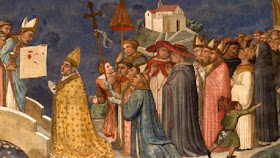Eucharistic Miracle
Bolsena, Italy - 1263
Feast Day Corpus Christi
Feast Day Corpus Christi
Before we discuss the Eucharistic Miracle we have to set the background.
Saint Christina of Bolsena
3rd Century Martyr
3rd Century Martyr
Saint Christina lived during the 3rd century. She was the daughter of the Roman pagan, Urbain. He was a powerful magistrate who was sent to command the military in Bolsena. Urbain was a staunch believer in the rituals of Paganism and he surrounded himself and his home with idols made of gold.
Christina broke the idols and gave the pieces of gold to the people living in poverty around the village. Her father was furious and spent the rest of his life attempting to convert Christina back to Paganism. And when that failed, she survived many of his attempts to kill her.
Once her father had her body torn with iron hooks and tied to rack over a fire. The flames on the fire blew away from Saint Christina and killed many of the bystanders. Another time a stone was tied around her neck and she was thrown into Lake Bolsena. The stone became buoyant and pushed Saint Christina to the surface.
After a number of attempts to take her life, Saint Christina finally received her martyr's crown at the age of eleven or twelve when she was pierced with arrows in the Amphitheater in Bolsena. Her feast day is June 24.
Saint Juliana of Liège
(1193 - 1258)
Juliana and her twin sister, Agnes, were born in a village near Liège, Belgium. They were orphaned at the age of five and were placed in a home that was overseen by the Norbertine Sisters.
Juliana entered this order at the age of 13. When she was 16 she began to have visions of the full moon streaked with a black band. In time Our Lord explained this vision to Juliana as the moon symbolizing the Christian year with all its feast days. The black band represented the one feast that was missing from the calendar, one in honor of Jesus in the Blessed Sacrament.
Juliana wrote to the Bishop of Liège, Robert de Thorete, and to the Archdeacon of Liège, Jacques Panaléon and explained the vision as the Lord as explained it to her. She expressed to them that it was the Lord's desire that a feast be established in honor of His Blessed Sacrament. Juliana would die in 1258 before seeing this become a realization.
Father Peter of Prague
In 1263, a priest known as Father Peter of Prague was on his way to Rome on pilgrimage. He was having great doubts about the physical presence of Jesus in the Eucharist. In the village of Bolsena, about 70 miles north of Rome, he stopped at the Church of Santa Christina for the night.
In 1263, this was a small church built over the catacombs where the remains of the 3rd century martyr Saint Christina of Bolsena was buried.
Father Peter would take the Host 30 miles away to Orvieto, Italy where Pope Urban IV was staying at the time. Pope Urban IV was the former Archdeacon of Liège, Jacques Panaléon, whom Saint Juliana of Liège had told of her vision regarding the Blessed Sacrament.
Pope Urban IV pronounced this a Eucharistic Miracle and was prompted to create a feast in honor of the Blessed Sacrament. He commissioned Saint Thomas Aquinas to compose the Liturgy for the Most Holy Body of the Lord, Corpus Christi. Saint Thomas also composed the hymns O Salutaris and Tantum Ergo for this feast.
One year after the miracle, in August 1264, Pope Urban IV introduced Aquinas' composition, and, by means of a papal bull, instituted the feast of Corpus Christi. This is celebrated the first Thursday after Trinity Sunday (first Sunday after Pentecost) or the first Sunday after Trinity Sunday.
Present Day
Cathedral of Saint Christina
Usually when blood spills on marble floors it will not saturate the stone. The Granite of this Miracle was broken when a priest requested a piece for the altar of his new church. It was found at that time that the Precious Blood had penetrated the Marble.
All five pieces would remain at the Cathedral of Saint Christina. Four of the Sacred Marble pieces would be kept in a side altar behind panes of glass. The fifth piece behind the original altar where the miracle took place.
All five pieces would remain at the Cathedral of Saint Christina. Four of the Sacred Marble pieces would be kept in a side altar behind panes of glass. The fifth piece behind the original altar where the miracle took place.
Below the altar is a stone that Tradition holds is the stone that was tied around Saint Christina's neck in the 3rd century. Her feet prints show on the stone which in instead of pulling her to the bottom of
Lake Bolsena, became buoyant and served as her life vest.
Cathedral of Orvieto
Art
Saint Christina of Bolsena Holy Card.Saint Christina Pierced by Arrows.
Saint Juliana of Liege - Photo Public Domain.
The Mass at Bolsena - Fresco painted by Raphael in the Vatican Palace depicting the Miracle of Bolsena.
Current picture of the Basilica of Santa Christina, Bolsena, Italy - Photo Public Domain.
Fresco of the Corporal being shown to Pope Urban IV at the Bridge of the Sun - Ugolino d'llrio, Duomo of Orvieto, Italy.
Altar of Saint Christina in the Cathedral of Saint Christina, Bosena, Italy.
Cathedral of Orvieto, Italy - The Road Goes Ever On roadeveron.blogspot.com
Chapel of the Corporal - Orvieto, Italy, Ibid.









No comments:
Post a Comment